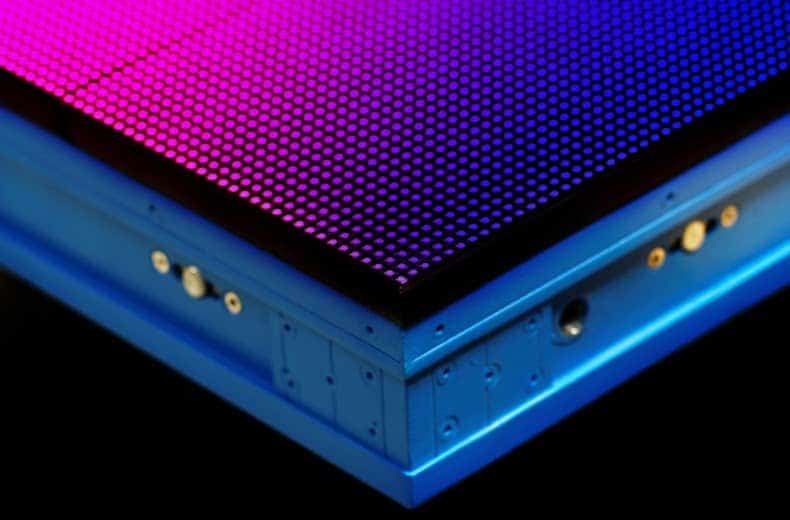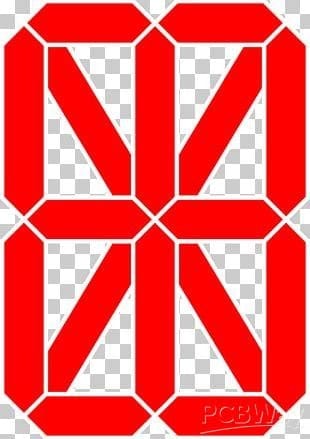There was a time when buying a display meant evaluating if you could even afford the space or the money for one. However, things have changed since then as those bulky CRT displays gave way to LCD (Liquid Crystal Display) technology.
But even LCDs didn’t last long, as technology got better and better. LED screens took over the market, and the leading LED screen manufacturer brands have dominated ever since.
Many people looking to buy a display wonder what an LED display is and how it functions. So in this article, you will learn all about LED screens, display types, how they work, and why you should get an LED screen.
Looking to buy? Check out our guide to buying an LED Display.
What is an LED Display?
LED stands for Light Emitting Diode. These diodes are tiny little bulbs that you might have seen on electronic devices.
Large LED displays use a large number of these diodes to light up the screen. These diodes are low power consumption devices that provide high brightness. As a result, an LED screen has several benefits over other display alternatives.
The fluorescent bulbs used earlier could only give black and white tones. However, an LED screen can display the entire colour spectrum by combining red, blue, and green colours (RGB).
The advantages of an LED screen are so many that you can find LED screens everywhere. From TVs to computer monitors to high-resolution billboards in shopping centres and LED video wall applications.
Short History of The Evolution of LED Displays
Even though LED display technology has become popular in the last 5-6 years, the evolution of the LED screen has taken over half a century. Here are some keystone events in this evolution:
- Nick Holonyak, an employee of General Electric, invented the first LED in 1962. It was a red LED and only red LEDs were available for the next 10 years.
- In 1969, Hewlett Packard made the first LED display- the HP Model 5082-7000 Numeric Indicator.
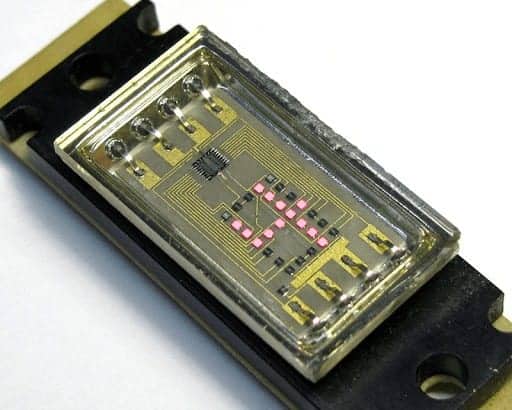
Image: HP Model 5082-7000 Numeric Indicator
- The first real application of an LED display takes place in U2’s Popmart tour of 1997. The display was 52m wide, 17m high, and used 150,000 light-emitting diodes. It was made on a mesh that could be rolled up for transport.
- In 2008, Sony created the world’s first OLED television, which was also the world’s thinnest TV at the time at a thickness of just 3 mm. This OLED television brought the benefits of LED screens to the limelight.
- By 2014, the manufacturing of plasma TVs was stopped in the US and replaced by LCD and LED televisions.
How Do LED Displays Work?
LED displays make use of a huge collection of light-emitting diodes on a flat panel. These diodes are either red, blue, or green. Each of these diodes is capable of emitting light of different brightness.
Just like you learned in art class, two or more colours can combine to create new colours. Similarly, red, blue, and green light from these diodes combined in varying ratios create every colour on the spectrum.
If you get close enough to an LED display, you can notice the individual diodes on the television panel.
Important Technical Terms to Know
While we are talking about LED technology, here are some technical terms that you should be familiar with:
- Pixel Pitch – Pixel pitch is the distance between the centres of two adjacent individual pixels on the LED panel. A short pitch results in high resolution and better picture quality. The minimum viewing distance from the LED display is also determined by the pixel pitch. If you view the LED display from a closer distance, you can spot the individual LEDs.
- Pixel Density – Pixel density is the number of pixels present on a given area of the screen. Generally, it is measured in pixels per inch (ppi). The quality of an image displayed on a screen improves significantly as the pixel density increases. Note that pixel density in smaller devices like the screen on your smartphones is considerably higher than large devices like a television or LED video wall. For instance, an iPhone may have a pixel density of over 458 ppi, while a 50-inch 4K TV might have only 80 ppi.
- LED Viewing Angle – The angle from the centre of the LED display at which picture brightness becomes less than 50% of the nominal. In simple terms, this angle tells us the maximum position at which the viewer can still clearly see the display image. For instance, if the angle is 40 degrees, the viewer can still see the image correctly 20 degrees left and 20 degrees right of the screen.
- LED Scan Rate – LED scan rate is a ratio that represents how much of the LED array lights up at a given point. For instance, a scan rate of 1:16 means 1/16th of the LEDs is lit at any given instant. After, the display moves to the next 1/16th. Not all the LEDs are activated. Doing so would result in high power consumption and require more processing power. Instead, a fraction of the LED array is lit at a given instant. Then the principle of Persistence of Vision is used, which means the image our eyes see lasts for a fraction of time.
What are the Different Types of LED Displays?
Based on their construction, LED screens can be categorized into various types. Each of these types has its purpose. Here are a few of the common categories:
Dot-Matrix LED Display
Dot-matrix LED displays are used to show numbers, alphabets, characters, and simple graphics. These displays consist of a rectangular array of LEDs followed by a space. They can be mounted serially to create a dot-matrix display.

These diodes are programmed to light up according to the number or character that is to be displayed. Each character requires about 5×8 pixels (or LEDs).
Because there is individual control over each LED, a dot matrix display provides more details and intricate graphics than a segmented display.
These displays can be used in meters, industrial controls, medical equipment, billboards, hoardings, and other uses.
7-Segment Display
7-segment displays are used to present numbers by splitting the display into 7 light segments.

These segments are arranged in a formation that looks like the number ‘8’. In this formation, every number from 0-9 can be presented by lighting the appropriate segment of the display.
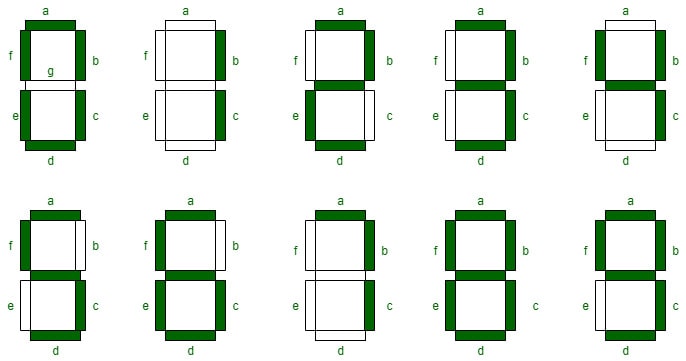
These displays are one of the most common and simple and you will find them anywhere numbers are to be presented. A common example of this is digital clocks, digital thermometers, calculators, and other digital communications devices.
It is important to note that while 7-segment displays can recreate all the numbers, they cannot be used for lettering.
14-Segment LED Display
14-segment displays retain the basic 7-segment shape, plus additional LED segments placed in the diagonals and centre of the 8 shape.
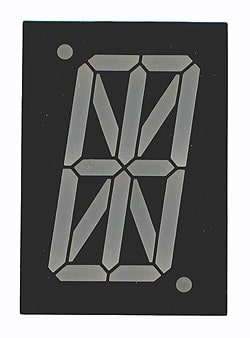
These added sections make it possible to display letters along with numbers. This configuration is also known as the Starburst LED display.
These displays were popularized by arcade games in the ’80s. Even today, they are used in a wide range of applications that require specific requirements, such as a retro look or a simple alphanumeric display.
16-Segment LED Display
16-segment LED display improves upon the 14-segment design by further splitting the top and bottom horizontal segments of the 8-figure. The addition of these segments adds some clarity when displaying alphabets.
Complex LED Displays
Segmented and dot-matrix designs are sufficient for basic graphics and alphanumeric characters. But they are unsuitable for purposes such as TV, computer monitors, or other displays that require recreation of a complete spectrum of colours and complex graphics.
For this purpose, the LED screens are large-scale in nature, employing millions of LEDs. Unlike the segmented displays, the complex large-scale arrangements do not have segments or gaps between the LEDs.
Benefits of LED Displays
One important question to ask at this point is ‘why are LED displays so popular?’. If you remember the LED technology that we mentioned earlier, you might have guessed the benefits it can provide.
Even so, the advantages of LED displays are far more than what meets the eye at first glance. Some of them are:
- Size: Light-emitting diodes are tiny. For this reason, LED displays are smaller than any other alternative display technology that you can think of. They can be one-third the thickness of an LCD of the same screen size.
- Power Consumption: LEDs consume a minimal amount of electricity. Therefore, even a large LED display consumes a fraction of the electricity consumed by similar-sized LCD screens.
- Image Quality: LED screens have an RGB contrast, which means they can recreate true blacks and true whites. This creates a better image quality than other displays.
- Lifespan: Due to no moving parts and a simple design, LED displays tend to last longer than LCD screens or other displays.
- Viewing Angle: LED displays are evenly lit. Therefore, they provide a wider viewing angle.
- Eye Strain: LED displays offer greater control over high brightness and other features that can help reduce eye strain.
What are the Applications and Uses for LED Displays?
Today, LED display solutions are used in a wide range of applications. Some of these include:
- Television: TVs are the most popular application of LED screens right now. LED TVs have replaced almost the entire plasma and LCD screens market. Even within LED TVs, multiple technologies have come up, like the OLED and QLED TVs.
- Monitors: Computer monitor technology goes hand in hand with television technology. This is why monitors have also shifted towards LED technology. These are perfect for all computing applications, be it entertainment, work, or gaming.
- Smart Phones: Smartphone screens are crossing boundaries of high-definition picture quality, all thanks to LED displays. LED displays in smartphones are ultra-thin, with very high pixel quality.
- Advertising: There is no limit to how large an LED display sign can be. This is why outdoor and indoor screens are very popular nowadays for LED advertising and digital signage. You can find them used on all types of business, entertainment and sports events.
- Electronic Devices: Simple LED displays (like segmented displays) are used in electronic panels for showing alphanumeric characters.
How are LED Displays Going to Develop in the Future?
Even though LED screens have already replaced display technology everywhere, they still keep on evolving.
CRT displays remained in use for more than three decades. LED technology has been popular for only about six years, so it can be expected that it is going to remain for a long time.
One of the major driving factors for these displays is the various use cases outside of replacing television and indoor LED screens. Large LED displays such as LED video walls for advertising and digital signage in shopping centres are now common. These solutions make LED display technology much more diverse than any previously available solution.
While LED screens are already thinner than other alternatives, the size can be expected to be toned down even more. Another prediction is that the size of individual diodes decreases, thereby increasing the pixel density and significantly boosting the quality of an image on even the largest outdoor screen.
Endnotes
If you are thinking about buying an LED display for your personal or professional needs, don’t doubt your decision.
LED screens are the best technology available right now, whether you consider it as television on your living room wall or an advertisement window outside your office.

